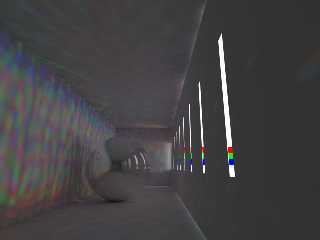|
 |
Let me explain first:
There is a room, divided by a wall. This wall has several holes.
in one half of the room, there are some bars in the full length
of the room, having ambient 1, so they are the light_sources ...
But: I used one Red, one Green and one Blue lightsource ...
.. so in theory, there should be a quite neutral color in the
shadows in the other half of the room, with only some colors at
the edges of the shadows ...
As you can see, the distribution of radiosity-traces implicits
some nice colors, but I don't want to be on XTC....
another interesting artefakt is, that the separating wall (which is very
thin), has
lights in its edges, where it sould be the darkest point in the room ...
Yes: I'm sure this wall leaves no space for light, to travel through
at this point...
I found out, that increasing recursion minimizes this effect, but I don't
want
to go deeper.
Are there some ideas, in which direction I should change the params ?
I found out:
- that decreasing recursion makes the edges even more lighter,
so I don't think this can be lowered ...
- that I don't intend, to increase count even more ...
source follows:
BTW: This image rendered in 1280x960 in 56h30min
------------------------------------
#declare Radiosity=yes; // use +QR on commandline
global_settings {
assumed_gamma 1.0
file://max_trace_level 25
#if (Radiosity)
radiosity {
pretrace_start 0.005 // start pretrace at this size
pretrace_end 0.0025 // end pretrace at this size
count 786 // higher -> higher quality (1..1600)
[35]
nearest_count 10 // higher -> higher quality (1..10) [5]
error_bound 0.1 // higher -> smoother, less accurate
[1.8]
recursion_limit 13 // how much interreflections are
calculated (1..5+) [3]
low_error_factor .2 // reduce error_bound during last
pretrace step
gray_threshold 0.0 // increase for weakening colors (0..1)
[0]
minimum_reuse 0.005 // reuse of old radiosity samples [0.015]
brightness 1 // brightness of radiosity effects (0..1)
[1]
adc_bailout 0.01/2
}
#end
}
#default {
texture {
pigment {rgb 1}
#if (Radiosity)
finish {
ambient 0.0
diffuse 1
specular 0.3
}
#else
finish {
ambient 0.1
diffuse 0.6
specular 0.2
}
#end
}
}
// ----------------------------------------
camera {
location <-2,3,-4>
angle 80
look_at <-2,4,0>
}
#if (!Radiosity) light_source { <9,5,9>, color rgb 128 fade_distance 1.28
fade_power 2 area_light z*8,y*8,11,11 orient adaptive 2 jitter} #end
#declare room=difference {
box {
-50,50
pigment {checker color rgb 1 color rgb 0.95}
}
box {
<-10,0,-10><15,10,30>
pigment {checker color rgb 1 color rgb 0.95}
}
}
#declare wand=difference
box {
<-0.01,-1,-11><0.01,11,31>
}
#declare i=10;
#while (i>0)
box {
<-1,-1,-1><3,1,1>
scale <1,2.25,0.2>
translate <0,5,i*3.5-2>
}
#declare i=i-1;
#end
}
#declare
box {<14.5,4.5,-10><16,5.5,30>}
box {<0.5,4.5,29.5><16,5.5,31>}
box {<0.5,4.5,-9.5><16,5.5,-11>}
finish {ambient 1}
}
object{licht translate 1*y pigment {color rgb x*15}}
object{licht translate 0*y pigment {color rgb y*15}}
object{licht translate -1*y pigment {color rgb z*15}}
sphere {
0,3
translate <-6,3,15>
finish {
ambient 0
diffuse 0
reflection 1
specular 0
phong 0
}
normal {
crackle 0.2
scale 0.001
}
}
union {
object {room pigment {color rgb 1}}
object {wand pigment {color rgb 1}}
}
------------------------------------
--
Jan Walzer <jan### [at] lzer net> net>
Post a reply to this message
Attachments:
Download 'radiosity_test2.png' (182 KB)
Preview of image 'radiosity_test2.png'

|
 |




![]()